| |
In its FY 2000-2005 Strategic Plan, the U.S. Department of Transportation created a new strategic goal, "Organizational Excellence," which focuses on the internal operations of the organization. The Federal Highway Administration (FHWA) uses Corporate Management Strategies–-the President's Quality Award Criteria--as a guide for internal operations. While the CMS fully support the DOT goal, for simplicity and alignment, FHWA will adopt an Organizational Excellence goal in FY 2002 that directly aligns with the DOT Strategic Plan. In looking ahead, this appendix provides a preview of that goal along with performance goals and measures specific to FHWA.
|
|
As Measured by... |
FHWA Corporate Management Strategy |
|
Improve customer satisfaction |
User satisfaction with highways User satisfaction with intermodal linkages Public satisfaction with highways as a beneficial part of their community |
Customer/Partner Focus |
|
Improve employee satisfaction and effectiveness |
Employee job satisfaction Employee investment Employee turnover Minorities and women in senior positions |
Human Resource Development and Management |
|
Improve organizational performance and productivity |
Unexpended balances Value engineering savings |
Leadership Strategic Planning Information and Analysis Process Management |
|
|
Strategic Objective: Improve customer satisfaction.
Performance Goal: Increase user satisfaction with the Nation's highway systems and intermodal linkages to meet customer needs. (See Mobility Goal).
Performance Measure (1): Percent user satisfaction with the Nation's highway systems
The National Quality Initiative survey included one specific question that asked respondents to provide their overall satisfaction with the highway system; this is the overarching measure. The top three stated priorities for improvement ranked by survey respondents include: safety, pavement conditions and traffic flow. The percentages represent either very satisfied or satisfied.
|
SURVEY RESULTS ? |
|
|
|
Overall Satisfaction |
|
|
|
48% 47% |
59% 47% |
Performance Measure (2): Percent user satisfaction with the Nation's intermodal linkages
User satisfaction for passengers using intermodal linkages will be captured in the Traveler Perception Survey in 2002.
Strategic Objective: Enhance community and social benefits of highway transportation.
Performance Goal: Increase public satisfaction with highway systems and highway projects as a beneficial part of their community by promoting responsive and well targeted transportation programs. (See Environment Goal).
Performance Measure: Level of Community Satisfaction with the Nation's highway system and projects toward meeting community quality of life goals (also see Mobility Goal).
|
|
Strategic Objective: Improve employee satisfaction and effectiveness.
Performance Goal: To increase employee satisfaction
Performance Measure: Percent employee job satisfaction
The All-Employee Survey will provide the basis for determining overall employee satisfaction. Job Satisfaction was determined to be the overarching measure for this category of indicators. The percentages represent either "strongly agree" or "somewhat agree."
|
|
|||
|
|
|
|
|
|
Job Satisfaction |
|
|
|
|
|
|
|
|
|
|
|
|
|
|
|
|
|
|
|
|
|
|
|
|
|
|
|
|
|
|
|
Performance Goal: Maintain (employee investment) level consistent with program size
Performance Measure (1): Percent of payroll for training and development
There are many indicators of the effectiveness of training and development; however the percent of payroll is of primary importance to be tracked at the agency level.
Training and development is the primary tool for delivering new knowledge, molding current skills, and imparting new skills, as well as another source of employee satisfaction.
| NOTE: | Investment calculated as a percent of payroll (salary plus benefits). Percentages represent total investment in training including tuition, contract costs, participants travel and perdiem and instructor travel for all training and career development courses and programs for FHWA employees. |
Performance Measure (2): Total program dollars vs. staffing level
This measures the total program dollars vs. staffing level. To increase employee productivity and to remain effective, FHWA's investment in employee skill development, information technology, safety oversight, etc., should be rising even though overall General Operating Expenses (GOE) should be set at as efficient a level as possible.
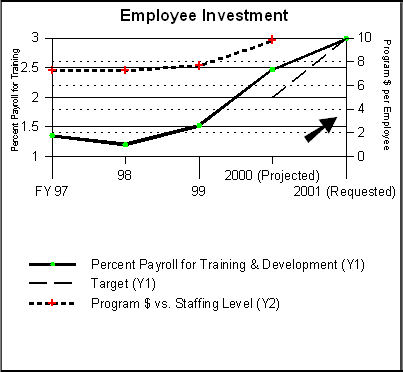
Performance Goal: Reduce employee turnover
Performance Measure: Percent employee turnover
Rates should be segregated by separation type and the data augmented by exit interviews in order to provide data on causes of separations.
|
Total separations and their causes.
|
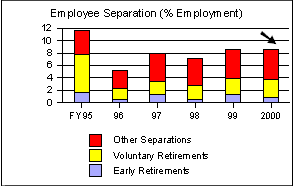 |
| NOTE: | In FY 1995 (203 buyouts), 1996 (1 buyout), and 1997 (61 buyouts), a total of 265 employees separated due to the Voluntary Separation Incentive Program. These employees were included in either voluntary retirements, early retirements, or other separations. |
Performance Goal: Increase minorities and women in senior level positions
Performance Measure: Percent of minorities and women in senior level positions
This measures the percent of minorities and women in senior level positions. The objective is to implement DOT Order 3200.1, Diversity Management Guidance, and report to the Office of the Secretary on key management objectives which call for creating and maintaining a highly competent, diverse work force that meets America's transportation needs in the 21st century, and provides accounting for measurable progress.
|
NOTE: (1)Senior level employees are defined as employees in Grades 13 through 15 and Senior Executive Service. (2)The FHWA Multi-Year Affirmative Action Plan (MYAEP) for 1999-2003 acknowledges progress has been made in staffing and promoting women and minority employees into senior level positions (GS-13 and above); however, the report points out that there is continuing under representation of women and minorities in key field leadership positions. Implementation of the MYAEP and accountability for progress rests with each organization and its respective managers. |
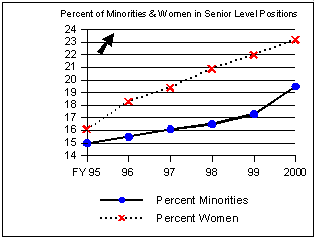 |
|
|
|
Strategic Objective: Improve organizational performance and productivity. Performance Goal: Reduce the amount of unexpended balances Performance Measure: Amount of unexpended balances This measures the annual amount of Federal-aid funds obligated but not expended on projects of $1 million or more and with no billing activity (including completed projects) for more than a year. |
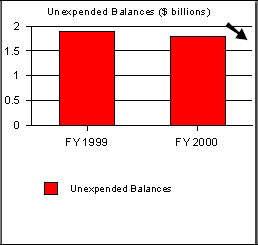 |
|
Performance Goal: Increase the use of Value Engineering (VE) Performance Measure: Amount of VE savings The National Highway System (NHS) Designation Act of 1995 requires all State DOTs to perform a VE analysis for projects on the NHS valued at $25 million or more. Data shown are total savings, regardless of project cost, from all VE recommendations approved including federal lands. |
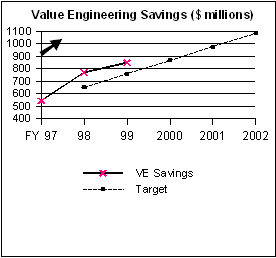 |